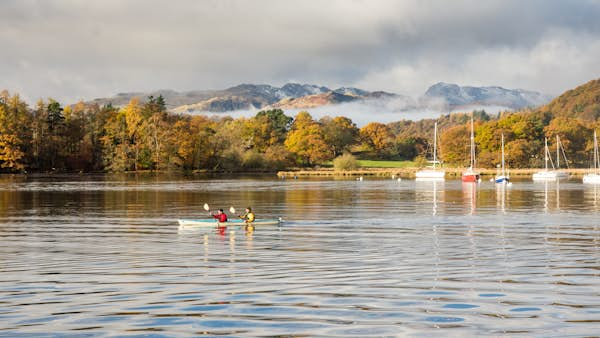8 of the best cycling routes in Germany
One of the best ways to discover Germany is by bike. Whether zipping around a new city, zooming along a river, winding through vineyards or circling a lake, every route offers an alternative vantage point from which to see the country.
While some trails might take a few hours to complete, others can take days, even weeks, crossing diverse landscapes and maybe even different federal states. Along the way, you’ll find fantastic guest houses and great places to eat, scenic spots to take a break, and plenty of locals following the same routes. So grab your wheels and hit the road, starting with some of our suggestions below.

1. The Berlin Wall Trail (Berliner Mauerweg)
Best for history
163km (101 miles); easy
This trail in the German capital traces the former GDR border fortifications around West Berlin. Open since 2006, the easy-to-follow route mainly sticks to old patrol and border control roads, with regular signposts and maps to help you stay on track. There are also photographs and information signs at a number of points, detailing life in the divided city. At times, you’ll be highly aware of the history and significance of the journey; at others you’ll completely forget and be more focused on the nature that has returned.
Broken up into 14 sections, the route can be done in a day, or bit by bit, with good public transport links helping you dip in and out – just remember to also pay for your bike when buying a ticket. Alternatively, you can stay in the center and join a shorter bike tour along the inner-city section with a guide.
2. German Wine Cycle Route
Best for reliable weather
97km (60 miles); moderate to difficult
Starting in Bockenheim and ending in Schweigen-Rechtenbach on the French border, the popular German Wine Route runs through the heart of the Palatinate (Pfalz), one of Germany’s largest wine-growing regions. Here you’ll find vine-covered hillsides, rambling forests, picturesque hamlets and exceptional wine estates, as well as local almonds, figs and lemons thanks to the moderate climate.
The sunny weather, along with the bike-friendly infrastructure, make it easy to plan a trip here. Pop into a tourist office for various cycling maps and details on bike rentals, and be sure to plan the occasional stop at a winery or an end-of-day drink in a local tavern.
For more wine-focused routes, try the Baden Wine Cycle Route in the south west, or the Moselle Cycle Path that takes you to some of the country’s oldest and most famous wine towns.

3. 100 Castles Route (100-Schlösser-Route)
Best for… castles!
960km (597 miles); easy to moderate
Meandering through the Münsterland region in the state of Nordrhein-Westfalen, these four interconnecting circuits encompass a dense collection of castles, gardens, fortresses and moated estates, in a mix of Baroque, Renaissance and Gothic styles.
The loops are divided into north, south, east and west. Try the southern one (210km/130 miles) for the shortest option or the northern one (305km/190 miles) for the higher terrain of the Tecklenburger Land area. Shorter day routes are possible too, starting at around 22km (14 miles). Also don’t miss the city of Münster, itself a cycling hub with a car-free ring around the center and a well-developed network of bike lanes.
4. Hessen Railway Cycle Route (BahnRadweg Hessen)
Best for a round trip
245km (152 miles); easy to moderate
As the name suggests, this long-distance option follows disused railway lines in the state of Hessen. The route starts in Hanau, the birthplace of the Brothers Grimm, and ends in Bad Hersfeld, with additional paths making it possible to organize a round trip. You’ll pass impressive castles and monastery ruins, attractive towns, such as Lauterbach and Fulda, and the picturesque low mountain ranges of Vogelsberg and Rhön.
Thanks to gentle railway inclines and tarmac surfaces, the route is rarely strenuous. Look out for iron bridges, old train carriages and tunnels: on a stretch known as the Milseburgradweg, you’ll need to trust that the motion-sensor-controlled lights will come on as you head into a kilometer of darkness!

5. Elbe Cycle Route (Elberadweg)
Best for city stops
1270km (789 miles); easy to moderate
The Elbe Cycle Route covers almost 1300km and the entire length of Germany’s second-longest river. It is also one of the most-loved routes in the country according to the General German Bicycle Club (ADFC).
While the route (and the river) actually starts in Czechia, it crosses the German border close to Schöna before heading to the striking rock formations in Saxon Switzerland. From here, it’s around 40km (25 miles) to the beautifully restored city of Dresden with its Frauenkirche and Renaissance city palace. Keep going for more towns and cities, such Magdeburg, Dessau and Hamburg further north. The final destination is Cuxhaven, where the Elbe flows into the North Sea.
Due to its length, the Elbe cycle route can take around two weeks to cover in its entirety and longer if you want to make stops. As a result, many people choose to focus on certain sections, such as Dresden to Hamburg, or even Prague to Dresden. There are a number of tour companies that can book your accommodations and organize luggage transfer between stops.
6. Chiemsee Bike Route (Chiemsee Radweg)
Best of Bavaria
52km (32 miles); easy to moderate
With views of the water, the alpine foothills and high peaks beyond, this route around Bavaria’s largest lake is a must for exploring more of Germany’s southern state. Start in Übersee, reachable by train from Munich, and go either way around the shores – watching out for pedestrians who share the route. It shouldn’t take longer than half a day to complete.
You’ll see lots of places to stop for a swim and pass the main boat departure area with options to reach the islands. There are bike services and rental options in most towns along the route.

7. Baltic Sea Cycle Route (Ostseeküsten-Radweg)
Best for families
1140km (708 miles); easy
Running between Flensburg near the Danish border and Ahlbeck on the Polish border, the German section of this coastal route tops the states of Schleswig-Holstein and Mecklenburg Western-Pomerania. Come for sand, sea, rugged coastlines and changeable weather.
Highlights include the cliffs in Rügen, the UNESCO World Heritage Sites of Wismar and Stralsund, and the city of Lübeck, known for its distinctive brick architecture and marvelous marzipan. The route is pretty flat, with plenty of options for beach breaks, making it a great option for all abilities and ages. Some people split the trip into two parts using Lübeck as the division. Alternatively, you could extend the trip by carrying on into the neighboring countries.
8. The Industrial Heritage Route (Die Route der Industriekultur per Rad)
Best for unusual architecture
700km (435 miles); easy to moderate
Germany’s Industrial Heritage Route links sites connected to the history and culture of the Ruhr region, once a major center for coal mining and steel production. Here structures such as blast furnaces and gasometers still stand, but many are now used as cultural venues, sports centers or parks. One of the best ways to visit the different spots and take in the whole landscape is by bike, with hundreds of kilometers of trails covering the area.
The two main routes are the Emscher Park Cycle Path (Emscher Park Radweg) and the Ruhr Area Circuit (Rundkurs Ruhrgebiet). The latter is almost 300km-long (186 miles) and passes steel mills, collieries and workers’ settlements, as well as some of the biggest sites in the area: UNESCO World Heritage Site Zeche Zollverein and the Gasometer Oberhausen. Paths connecting these two routes also allow you to create shorter circuits.












